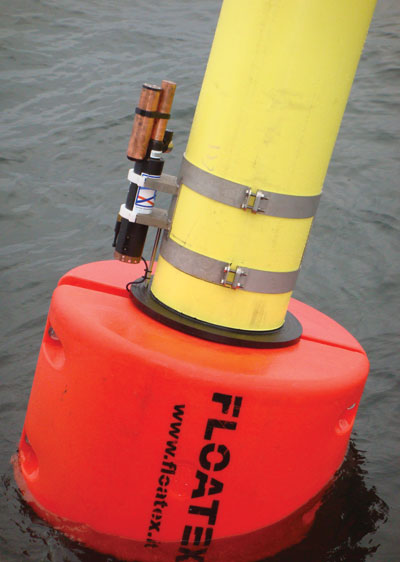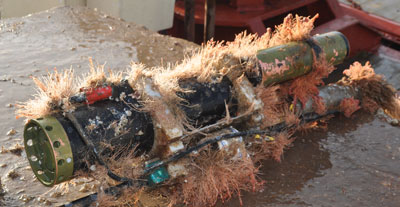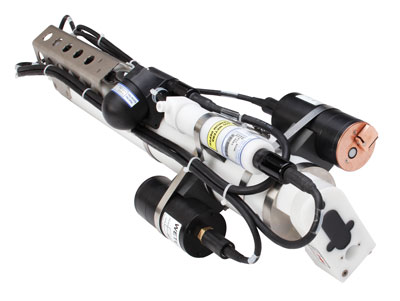| As seen in | Volume 18, Issue 11, December 2012: |
Environmental Monitoring
of Dredging Operations
Thomas O. Mitchell Ph.D., Sea-Bird
Electronics and Ian Walsh, Ph.D.,
WET Labs
![]()
Article in pdf format Link to technical papers Subscribe to Ocean News & Technology
The global trends of increasing awareness of environmental impacts from human endeavors and resource operations in remote locations are colliding in dredge activities. This collision is driving innovation in dredge-monitoring technology, resulting in higher quality data arriving at decision makers’ desktops in near real time. Going forward, high-quality data sets from dredge-monitoring operations will be important enhancements to ocean and coastal observing systems.
Dredging along coastlines is increasingly key to sustaining economic activity. Comprising roughly 4% of the world’s surface and supporting over 30% of the world’s population, coastlines have an economic importance disproportionate to their geographic extent. Commercial improvement and maintenance of coastal waterways through dredging and port construction is vital to support local economies; at the same time, care must be taken to preserve the local ecosystem, which holds intrinsic as well as significant economic value. This is especially true when dredging operations occur where tourism-based economies rely on pristine water quality to sustain their reputations.
Dredging is typically conducted in waters less than 25 m deep, which means the entire water column is in the photic zone where biological activity is concentrated. Monitoring this environment can be difficult from a sensor standpoint because although gradients are often very small, these changes can lead to large changes in biological communities. Bio-fouling prevention, careful consideration of deployment systems, and regular, routine maintenance of sensors all help to assure the highest quality data over the longest time, which is necessary to effectively monitor stress to the environment.
Dredging near coral is a difficult and potentially ecologically harmful activity. When mechanically disturbed, corals release micron and sub-micron sediment, creating highly turbid waters with suspended solids that can stay in suspension for days. The creation of particulate and suspended solids is also seen in dredging of non-coral material, including both hard and soft material in access channels and harbors. Because the material is in some cases suspended for long periods of time, the turbid plumes are carried by current and wave action to nearby areas, shadowing corals and settling on and sometimes smothering coral polyps. In addition, there may be increased release of nutrients that can result in decreased oxygen levels.
A number of water quality parameters can be monitored to determine the impact of dredging near a site. High-accuracy measurements of conductivity and temperature as a function of depth are key to providing a baseline reference of the local ocean density and temperature. Monitoring of turbidity, typically in NTU units, is a first step in quantifying the impact of sediment plumes on coral reefs. Monitoring of photosynthetically active radiation (PAR) is thought to be a better measure of true impact on a coral colony as it is a physical measure of the incident light over a broad spectrum, more accurately reflecting the light utilized by the coral ecosystem to sustain life. Dredging and the subsequent dumping of material can lead to an increase in nutrient concentrations, potentially resulting in anoxia/hypoxia indicated by a reduction in dissolved oxygen levels. Thus monitoring of dissolved oxygen in an impacted area provides an indication of the stress level in the photic zone.
Field Experience
Environmental monitoring takes place within the dredge area as well as in nearby reference sites, with data collected at 15-minute intervals and transmitted to a central data center on an hourly or daily basis. Monitoring often starts a year or more before construction, providing a seasonally accurate baseline for future reference.
Sea-Bird Electronics and WET Labs have both adapted their instruments to the needs of the dredge-monitoring community. Anders Jensen, business area manager for survey and monitoring for DHI, has worked closely with WET Labs and Sea-Bird. “We built our buoy systems for the Fehmarn Belt Fixed Link project with WET Labs WQMs and Sea-Bird Inductive Modem technology, with great success. When we had a need for a dredge-monitoring solution, WET Labs and Sea-Bird suppliedthe WQM-Dredge, which provides us salinity, temperature, depth, and turbidity. Our experiences with the WET Labs and Sea-Bird instruments have been remarkably good; they provide high-quality data under demanding conditions. With their instruments, we are confident that our buoy system can provide up to 6 months of data. In fact, battery power is our main limitation, not the instruments. We are also very impressed with the quality of the data from the sensors. DHI performed our own laboratory calibration of the WET Labs ECO NTU against suspended sediment and confirmed that the sensors are very sensitive instruments that can measure small concentrations of suspended solids very accurately. This is very important in remote areas where the water is clear and discriminating dredging plums can be difficult."
Jensen also states, “As a full-service provider of marine environmental-monitoring systems, DHI expects, and our clients demand, reliability. We build our buoys to provide this with near real-time delivery of data to the web and data redundancy in the instruments on the buoy as back-up. DHI’s Aquaguard controller communicates with the instruments using Sea-Bird’s Inductive Modem technology, which has been the key to providing robust communication capability.” Live data from a DHI monitoring buoy at Storestrømmen in Denmark is available at http://datacenter.dhi.dk/storstrom/. (select Measurements/demo).
 WET Labs WQM as it is being deployed on DHI buoy, Fehmarn Belt Fixed Link Project (photo by DHI) |
 WET Labs WQM-Dredge upon recovery, showing significant bio-fouling along instrument but clear window resulting from use of Bio-wiper™, Fehmarn Belt Fixed Link Project (photo by DHI) |
Dredging and dredge-spoils monitoring increasingly occurs within fragile ecosystems and at remote locations. In some areas such as Western Australia, simply getting to the monitoring sites is time consuming and expensive. Martin Hills of Imbros, an Australian supplier of integrated water quality instrumentation, has worked with many of the consulting groups performing dredge monitoring in Western Australia. Hills stated, “The systems that we provide based on Sea-Bird Electronics’ SBE 16plus CTDs and WET Labs’ optical instruments have been the only ones that will operate and provide good data over a workable length of time. In Western Australia, it takes at least a week to move an instrument package in and out of the sites or for a site visit by a technician. The need to monitor continuously means that longer deployments reduce the cost of replacing or swapping instruments, resulting in immediate savings for the contractors and better data overall.”
Where hard bottom communities, corals, and sub-aquatic vegetation (SAVs) are potentially impacted by dredging, the underwater light field is a key indicator of stress on the communities. The underwater light field is most effectively measured directly with a PAR sensor. WET Labs’ PAR sensor is equipped with Bio-wiper™ technology to keep the optics clean and reduce sensor drift over long deployments. Imbros’ Martin Hills states, “The WET Labs ECO PAR sensor is the only PAR sensor that can stay in the field for as long as the CTD and turbidity sensor and still provide good data. Our clients have had great success with this sensor in the water. We have also provided the ECO PAR for use as an above water sensor; the Biowiper™ keeps birds from fouling the optics.”
 Sea-Bird SBE 16plus IM V2 SeaCAT CTD with SBE 63 Optical Dissolved Oxygen Sensor, integrated with WET Labs ECO-NTU and ECO-PAR sensors with Bio-wipers™ |
 Sea-Bird SBE 16plus V2 SeaCAT CTD integrated with SBE 18 pH sensor and WET Labs ECO-NTU sensor with Bio-wiper, prior to dredge monitoring deployment in Western Australia (photo by WorleyParsons, Perth, Australia) |
Conclusion
Environmental monitoring of dredging and port construction sites will become more extensive over time, as greater economic development takes place in and near ecologically sensitive areas. Currently, best practices for monitoring dredge sites include gathering accurate and drift-free conductivity, temperature, and depth data as well as monitoring turbidity, PAR, and dissolved oxygen. For more information on sensors and systems used in environmental dredge monitoring, please visit www.sea-birdscientific.com.
![]()
Sea-Bird Home Phone: (+1) 425-643-9866 E-mail: seabird@seabird.com